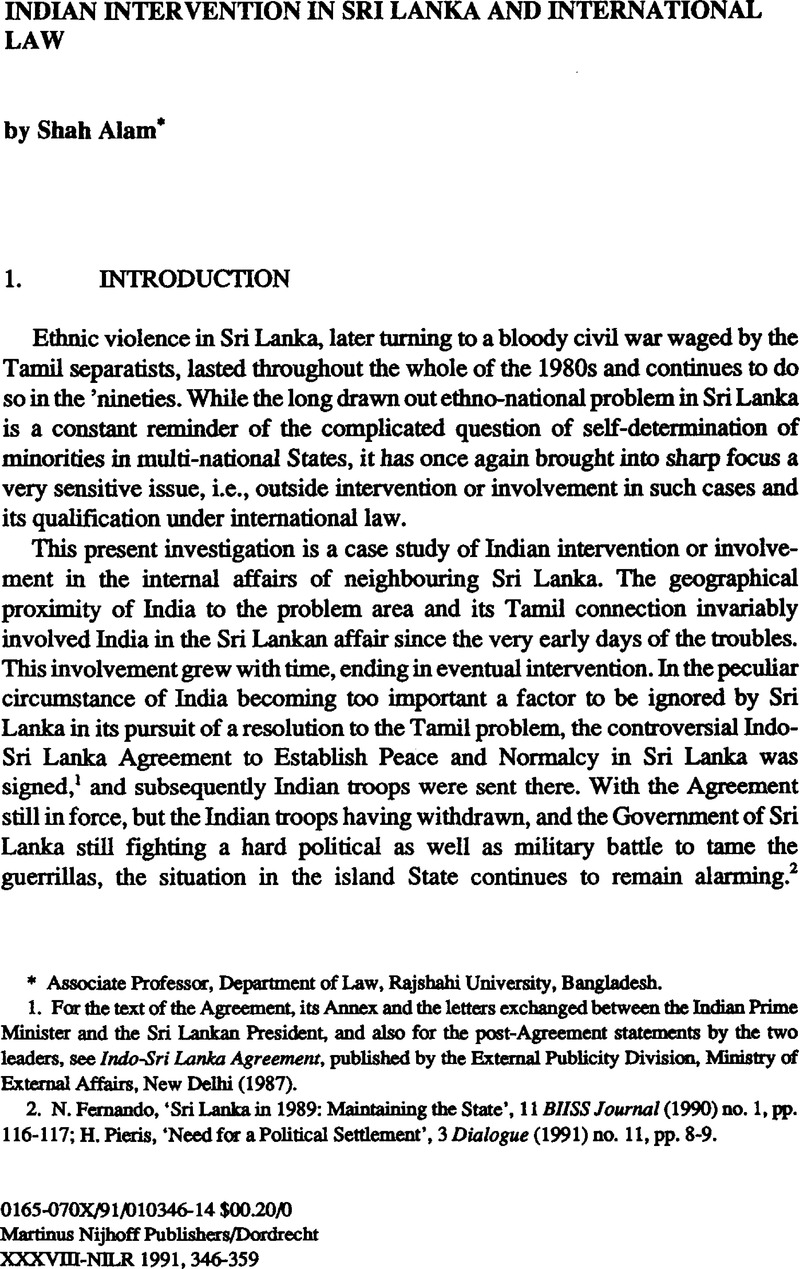Published online by Cambridge University Press: 21 May 2009

1. For the text of the Agreement, its Annex and the letters exchanged between the Indian Prime Minister and the Sri Lankan President, and also for the post-Agreement statements by the two leaders, see Indo-Sri Lanka Agreement, published by the External Publicity Division, Ministry of External Affairs, New Delhi (1987)Google Scholar.
2. Fernando, N., ‘Sri Lanka in 1989: Maintaining the State’, 11 BIISS Journal (1990) no. 1, pp. 116–117Google Scholar; Pieris, H., ‘Need for a Political Settlement’, 3 Dialogue (1991) no. 11, pp. 8–9Google Scholar.
3. Jafar, G., “The Tamil Factor: Genesis and Prospects of the Indian Stake in Sri Lanka’, 2 Regional Studies (1984) no. 2, p. 55, fn. 1Google Scholar; Pieris, , loc. cit. n. 2, p. 8Google Scholar.
4. A Memorandum on Discrimination, submitted to the International Commission of Jurists by the Tamil United Front, Colombo 1975Google Scholar.
5. See Poonambalam, S., Sri Lanka: National Conflict and the Tamil Liberation Struggle (1983) pp. 7–8, 177–185Google Scholar; jaffar, , loc. cit n. 3, p. 37Google Scholar.
6. The Tamails Fight for National Freedom, a memorandum submitted by the Liberation Tigers of Tamil Eelam to the Seventh Summit Meeting of Non-Aligned Nations held in New Delhi, 7–15 03 1983Google Scholar.
7. Newsweek (10 August 1987) p. 8.
8. Jaffar, , loc. cit n. 3, p. 25Google Scholar.
9. Indo-Sri Lanka Agreement, op. cit. n. 1, p. 3.
10. Shah, M. Azher Zafar, ‘India Trains Sri Lankan Terrorists’, Holiday (28 06 1985)Google Scholar.
11. Oppenheim, L., International Law, Lauterpacht, M., ed., 8th edn., Vol. I (1966) p. 305Google Scholar.
12. Ibid.
13. Starke, J.G., Introduction to International Law (1984) p. 99Google Scholar.
14. Kabir, M.H., ‘Crisis Management: A Case Study of Tamil Crisis in Sri Lanka’, 4 Regional Studies (1925) no. 1, p. 100Google Scholar.
15. Jaffar, , loc. cit n. 3, p. 44Google Scholar.
16. Kabir, , loc. cit n. 14, p. 100Google Scholar.
17. Ibid.
18. Ibid.
19. Azher Zafar Shah, loc. cit. n. 10; also see Fernando, , loc. cit. n. 2, p. 128Google Scholar.
20. Starke, , op. cit n. 13, p. 99Google Scholar.
21. Far details, see Islam, M. Rafiqul, ‘The Tamil Separatism in Sri Lanka: Some Factors Undermining the Claim’, 33 NILR (1986) pp. 65–83CrossRefGoogle Scholar.
22. Adar, K.G., ‘The Principles of Self-Determination and Territorial Integrity Make Strange Litigants in International Relations: A Recapitulation’, 26 IJIL (1986) nos. 3 and 4, p. 446Google Scholar.
23. Islam, Rafiqul, loc. cit n. 21, p. 83Google Scholar.
24. The Economist (3 August 1985) pp. 15–16.
25. Islam, M. Rafiqul, ‘The Use of Force in International Relations: The Indian Invasion of East Pakistan, 2 Lawasia, No. 2 (N.S.), MC(P) 132/7/83, pp. 181–182Google Scholar.
26. Tandon, M.P., Public International Law (1985) pp. 826–832Google Scholar; Jaffar, , loc. cit. n. 3, pp. 42–43Google Scholar.
27. Kabir, M.H., ‘Law and National Interests in International Relations’, 9 BIIS Journal (1988) no. 1, p. 18Google Scholar; Time (8 June 1987) p. 11; Newsweek (15 June 1987) pp. 10–11; Asiaweek (14 June 1987) pp. 15–22.
28. Ibid.
29. The UN Commission on Human Rights, the International Commission of Jurists and Amnesty International criticised and condemned human rights violations in Sri Lanka; on 12 June 1984, Amnesty International urged Presictent JuliusR. Jayawardene to prevent the killing of civilians by security forces; for details see Tandon, , op. cit. n. 26, pp. 826–832Google Scholar; also see The Times of India (3 July 1983); Rao, A., in Northern India Patrika (Sunday Magazine) (7 04 1985)Google Scholar.
30. Islam, Rafiqul, loc. cit. n. 24, p. 182Google Scholar; also see Fonteyne, J.P., “The Customary International Doctrine of Humanitarian Intervention: Its Current Validity Under the UN Charter’, 4 Cal. Western ILJ (1974) pp. 214–215Google Scholar.
31. Brownlie, I., International Law and the Use of Force by States (1963) pp. 338–339Google Scholar.
32. Oppenheim, , op. cit. n. 11, p. 312Google Scholar.
33. Reisman, M., ‘Humanitarian Intervention to Protect the Ibos’, in Lillich, R., ed., Humanitarian Intervention and the UN (1973) p. 168 (referred to in Rafiqul Islam, loc. cit n. 24)Google Scholar.
34. International Law Association, The International Protection of Human Rights by General International Law, Interim Report of the Sub-Committee, International Commission on Human Rights (1970)Google Scholar.
35. Brownlie, , op. cit a 31, p. 342Google Scholar.
36. Some argue that with the introduction of the UN Charter the right of unilateral intervention has vanished, see Kabir, , loc. cit. n. 27, p. 19Google Scholar.
37. Oppenheim, , op. cit n. 11, p. 313Google Scholar
38. Islam, Rafiqul, loc. cit. n. 25, pp. 187–189Google Scholar.
39. Newsweek (22 April 1991)pp. 10–11; Newsweek (29 April 1991) pp. 18–20.
40. Ibid.; The Bangladesh Observer (21 April 1991) p. 1, c. 6, 7 and 8.
41. Newsweek (6 May 1991) pp. 28, 33; The New Nation (25 May 1991) p. 4, c. 2.
42. Oppenheim, , op. cit. n. 11, p. 313Google Scholar.
43. Islam, Rafiqul, loc. cit. n. 25, p. 191Google Scholar.
44. Ibid.
45. Far details see Nanda, V.P., ‘Self-Determination in International Law: The Tragic Tale of Two Cities–Islamabad (West Pakistan) and Dacca (East Pakistan)’, 66 AJIL (1972) no. 2, pp. 321–336CrossRefGoogle Scholar; and Franck, T.M. and Rodley, N. S., ‘After Bangladesh: The Law of Humanitarian Intervention by Military Force’, 67 AJIL (1973) no. 2, p. 275CrossRefGoogle Scholar.
46. Islam, Rafiqul, loc. cit. n. 25, pp. 189–193Google Scholar.
47. A recent exception is the UN Security Council position and its decision on Iraqi aggression against Kuwait.
48. Iftekharuzzaman, M. and Kabir, M.H., “The Indo-Sri Lanka Agreement: An Assessment’, 8 BIISS Journal (1987) no. 4, pp. 462–463Google Scholar.
49. Ananda Bazar Patrika (8 August 1987).
50. Alam, S., ‘Indo-Sri Lanka Agreement and International Law’, 58 Nordic JIL (1989) p. 349Google Scholar.
51. Holiday (19 June 1987).
52. Iftekharuzzaman, and Kabir, , loc. cit. n. 48, pp. 463–464Google Scholar.
53. Alam, , loc. cit. n. 50, p. 349Google Scholar.